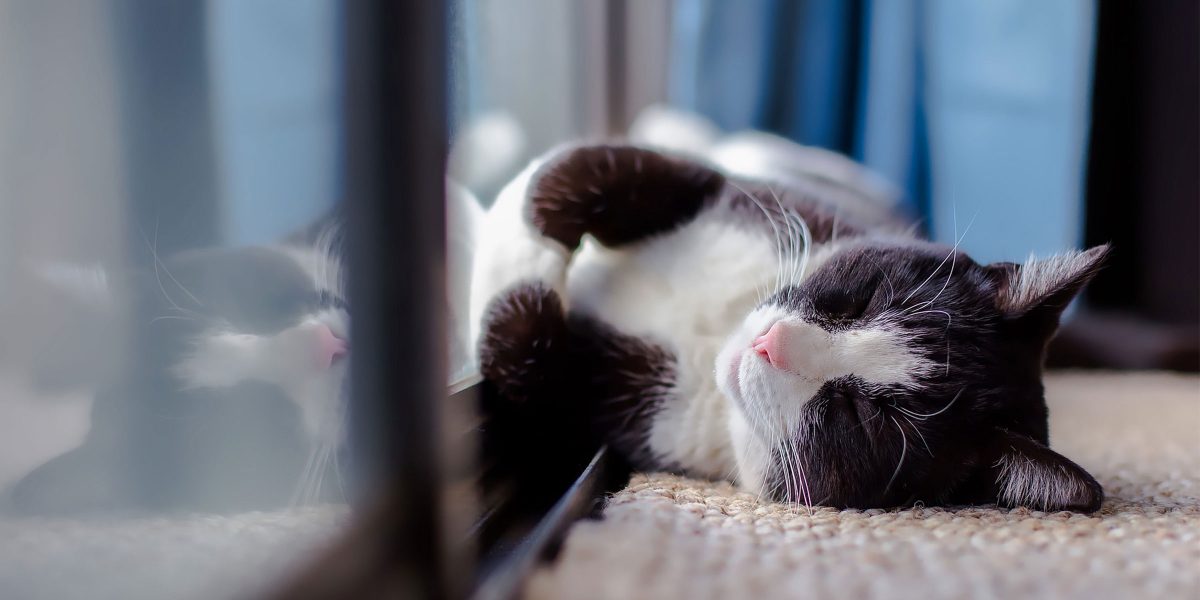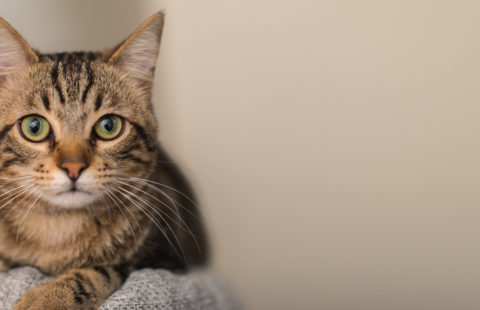Discussions around keeping cats strictly inside, or providing them with some form of outdoor access, can often be a divisive issue, with owners having strong but opposing views.

Rae Foreman-Worsley
These views might differ based on where a person lives and their general lifestyle, meaning relative proportions of indoor only versus indoor/outdoor cats vary substantially across the globe. In the middle of this is what’s actually best from the cat’s perspective and how easily their basic needs can be met, based on the lifestyles that are chosen for them by their owners.
These issues form the heart of iCatCare Feline Wellbeing Panel Member Rae Foreman-Worsley’s PhD research, carried out at Nottingham Trent University, UK. For this month’s Spotlight on Science, Rae shares with us some of her recent published findings focussed on trying to understand more about the demographics and owner rationale associated with choosing either an indoor only or indoor-outdoor lifestyle for cats.
Rae, tell us a little more about the theme of this research and your PhD
This study is just one part of my PhD. My PhD aims are to understand more about the welfare and management of cats in relation to their environmental provisions and the type of indoor/outdoor access they have. I am keen to explore whether cats’ behaviour and wellbeing is affected by the type of lifestyles they are exposed to, how owners make decisions regarding the way they manage their cats and potential differences across different regions of the world.
The results in my recently published paper came from a large international online survey. Participants responded to questions about themselves, and their cat’s living environments. These included the participant’s age and gender, country of residence, their house type (eg, apartment, terrace, detached) and area (eg, urban or rural) and the cat’s outdoor access (ie, indoor-only or indoor-outdoor). The survey also included questions about the cat’s temperament, incidents of any stress-related behaviours and the types of social interactions the cats had with other members of the household including adults, children, other cats and dogs. A lot of this data will be analysed and included in future papers, but for this study, I used a subset of this data alongside additional responses gathered from a second survey sent to participants. In this second survey, I asked participants how they made their choice between an indoor-only or indoor-outdoor lifestyle for their cat, and to also rate how strongly they considered different factors in this decision making.
Survey responses were then split into two groups; owners of indoor-only cats and owners of indoor-outdoor cats. The reasons provided by each group in relation to why they chose that particular lifestyle for their cat were analysed. Differences in the demographic features of both the cats and the owners from these two groups were also compared.
What were the main findings of the study?
Likelihood of having an indoor or outdoor cat
A range of cat and owner characteristics were associated with greater odds of owners either having an indoor-only or indoor-outdoor cat.
Owners were more likely to have an indoor-only cat if they:
- Were 26–35 years old compared to owners that were 36-45
- Owned more than one cat
- Lived in city centres or urban areas compared to the suburbs
- Lived in a flat/apartment compared to a semi-detached house
- Lived in the United States, Canada, Australia, or New Zealand compared the UK and Europe
As for the cats, they were more likely to have an indoor-only lifestyle if they:
- Were younger (eg, 7 months to 2 years old)
- Had health issues
- Were a pedigree
In contrast, owners were more likely to have an indoor-outdoor cat if they:
- Were 46–55+ years old compared to owners that were 36-45
- Had children (17 years old or under) living at home
And cats were more likely to have an indoor-outdoor lifestyle in they:
- Were male
- Were mature or senior (eg, 7 years old and above)
Why did owners make these decisions?
Indoor cat owners:
For owners of indoor-only cats, 18.7% of owners could not provide their cats with outdoor access as they lived in flats or apartments, and 73.1% of owners did have outdoor space but still kept their cats indoors. Interestingly, 8.2% of owners reported that it was the cat that made the decision to stay indoors and they wouldn’t go outside even if the door was left open for them (although we don’t know from the study how inviting and cat friendly these particular outdoor environments were, which could be a contributing factor!).
Traffic concerns were the most common reason given by owners who chose an indoor-only lifestyle for their cats, with a whopping 98.7% of indoor-only owners reporting it influenced their decision. Over half of these owners (58.7%) said this was the factor that influenced them most strongly, and this was consistent across owners in the UK and Europe, the USA and Canada, as well as Australia and New Zealand.
Interestingly, the second most common reason for choosing an indoor-only lifestyle varied by region. In the UK and Europe, owners said they wanted to protect their cat from other people, as they were concerned their cat might be stolen or harmed. In the USA and Canada, owners primarily wanted to protect their cats from common animal predators such as bears, eagles, coyotes and snakes. Interestingly, in Australia and New Zealand, owners wanted to stop their cats from hunting, as native birds in these regions are particularly susceptible to being hunted by predators.
Other considerations that influenced owners to keep their cats indoors ranged from being worried that their cat might get lost, to needing to give their cat regular medications for various illnesses.
Indoor-outdoor cat owners:
For indoor-outdoor owners, around 70% felt that the opportunity to explore outdoors was good for their cat’s mental and physical health.
When asked what the major reason was for providing their cats with outdoor access, 38% confirmed it was for the benefit of the cats’ mental health, and 18% for their physical health. Indoor-outdoor owners also mentioned prioritising what they felt their cats wanted (even when this wasn’t necessarily what the owner would prefer!), with 32.9% of owners saying the major reason they allowed their cat outdoors was because their cat wanted to go out. Owners also considered that outdoor access meant their cats could have space away from other cats they lived with, and because their cat liked to toilet outside rather than in an indoor tray.
This is really fascinating insight, how do you think the results will help cat welfare?
By understanding what is important to owners, their concerns and the factors that influence their decision-making, we will be better able to provide them with the right support and information to ensure their cats’ needs are being adequately met. Additionally, the more we understand about the potential impacts different lifestyles might have on cats’ wellbeing (my next papers), the better able we are to target our advice where it’s needed most. We can also make sure that we carefully match individual cats to the lifestyles we think they will be able to thrive within.
In the UK for example, studies suggest an increased trend in the number of cats kept solely indoors. These numbers are likely to continue to rise in line with increasing urbanisation. With greater demands for indoor–only cats, homing centres may need to think carefully about how they can assess their cats in order to gauge their potential suitability for indoor-only lifestyles. Meeting a cats’ emotional and physical needs when housed strictly indoors can be challenging, therefore such owners may be the most important to target in terms of providing advice.
For example, a young high-energy cat that requires a lot of cognitive stimulation but also benefits from time away from people, is unlikely to cope well in a typical indoor-only home. If this cat has ended up living with owners that do have access to a garden, but choose to keep him indoors due to fears over his safety, it may be possible to offer solutions that help to meet his needs but also ease owners’ concerns. In this case, strategies may include recommending the cat be let outdoors, but with a GPS device fitted to a quick release cat collar or installing ‘cat-proof’ fencing to the garden perimeter to stop the cat from being able to exit. The cat could also be taught a ‘recall’ to ensure the owner is able to quickly get him to come back indoors when needed (see video below for more information). An app-controlled microchip cat–flap might also enable the owner to remotely monitor his comings and goings, whilst at the same time giving him the freedom to go outdoors when he likes.
A huge thanks to Rae for sharing her research with us. To read her full paper, you can access it at the following link.
If you are thinking of getting a cat and do not know whether to let it outdoors or not, click here for info that may help with the decision-making process.
Also, if you are looking for tips on how to make your home cat friendly, click here.
Article reference:
Foreman-Worsley, R.; Finka, L.R.; Ward, S.J.; Farnworth, M.J. (2021) Indoors or Outdoors? An International Exploration of Owner Demographics and Decision Making Associated with Lifestyle of Pet Cats. Animals. 11 (2). 253. https://doi.org/10.3390/ani11020253
This piece is edited from an article first published in Your Cat magazine, written by Rae Foreman-Worsley and her PhD Supervisor Lauren Finka. We are extremely grateful to both Lauren and Your Cat magazine for their generosity in allowing us to utilise and repurpose this article and helping us share cat science to improve the understanding of cats internationally.






